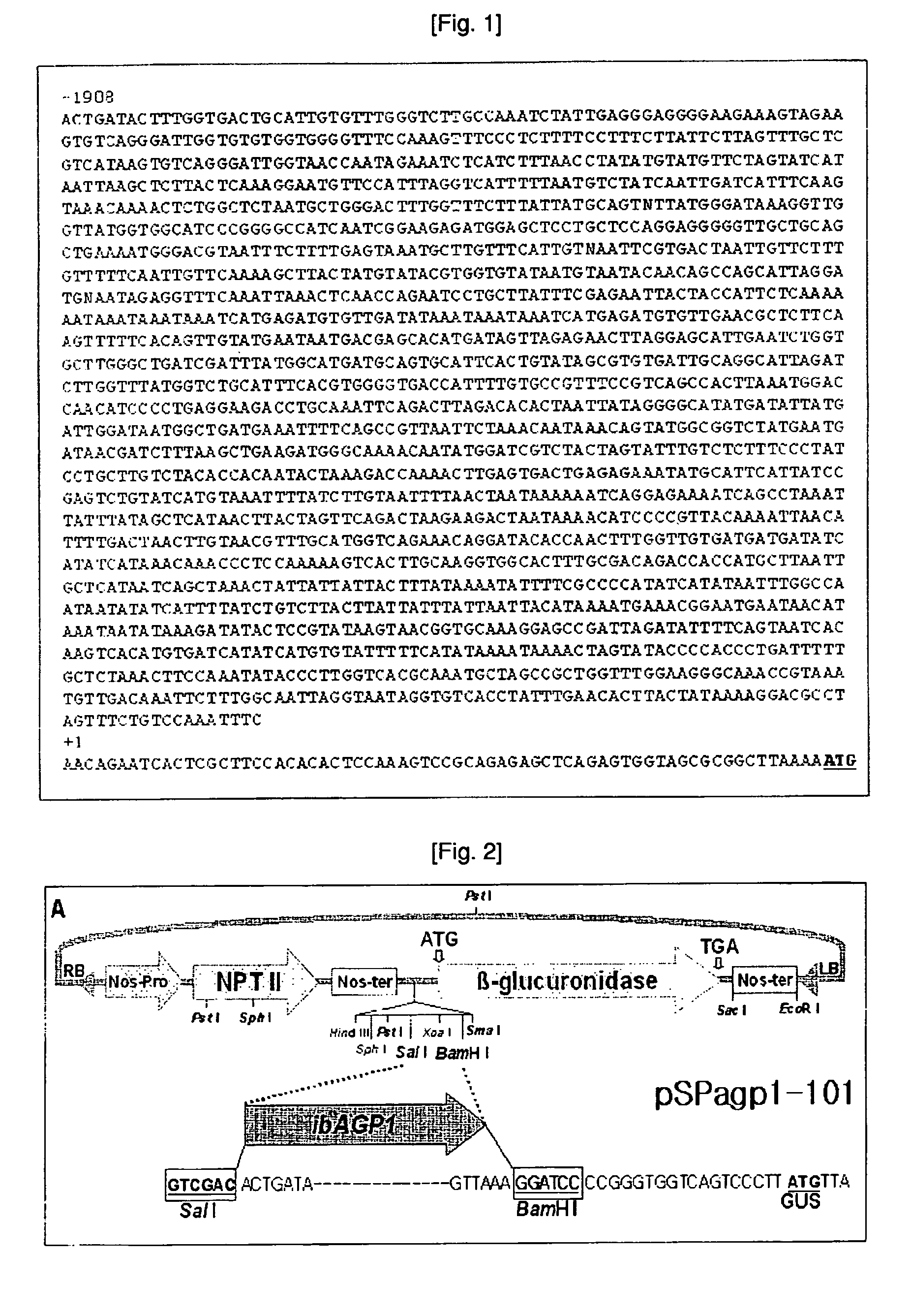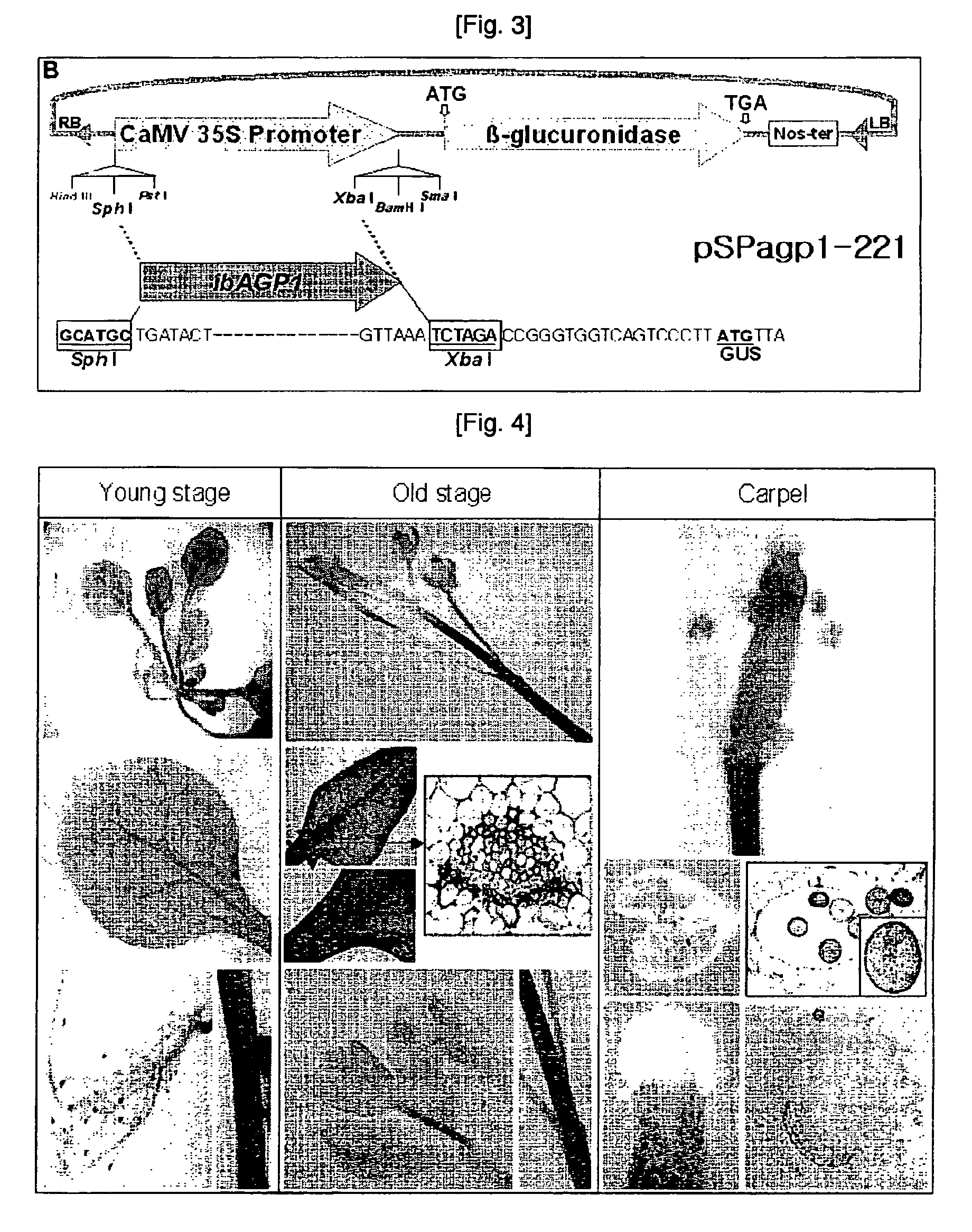Sucrose-inducible promoter from sweetpotato
a promoter and sucrose technology, applied in the field of plant sucrose-inducible promoter sequence, can solve the problems of low expression rate, unreported nucleotide sequence of highly efficient sucrose-inducible promoter, and high cost of medicinal or industrial products
- Summary
- Abstract
- Description
- Claims
- Application Information
AI Technical Summary
Benefits of technology
Problems solved by technology
Method used
Image
Examples
example 1
Cloning of the Sucrose-inducible Promoter of the Sweetpotato ADP-glucose Pyrophosphorlyase Gene (ibAGPl)
[0044] A promoter of the sweetpotato ADP-glucose pyrophosphorlyase gene (ibAGPl) was identified in the 5′ region sequence of the sweetpotato ADP-glucose pyrophosphorlyase gene (ibAGPl, Noh et al., GENE, 2004, 339, 173-180).
[0045] The 1,908 bp sequence of the cloned promoter was registered in NCBI GenBank (Accession no. AY694185, FIG. 1). FIG. 1 shows DNA sequences of a plant sucrose-inducible promoter and a 5′ untranslated region of the sweetpotato ADP-glucose pyrophosphorlyase gene (ibAGPl) according to the present invention. In FIG. 1, the start codon ‘ATG’ of protein synthesis is underlined and in bold type, and the base ‘A’ of the translation initiation site is indicated by ‘+1Λ
example 2
Construction of Plant Sucrose-inducible Vector and a Transient Expression Vector
[0046] The sweetpotato ADP-glucose pyrophosphorlyase gene (ibAGPl) promoter cloned in example 1 and a 68 bp 5′ untranslated region (SEQ NO ID: 1, FIG. 1) were inserted into pBHO1 or pBI221 (Clonetech) to construct a plant sucrose-inducible vector or a transient expression vector respectively.
[0047] More specifically, in the case of the construction of a plant sucrose-inducible vector, the sweetpotato ADP-glucose pyrophosphorlyase gene (ibAGPl) promoter, cloned in example 1, and a 68 bp 5′ untranslated region (SEQ NO ID: 1, see FIG. 1) were amplified by PCR and digested with Sail and BamHI. Then they were inserted into the Sail and BamHI sites of pBHO1. The vector was termed as pSPagp1-101 (see FIG. 2). The primers used in the above PCR are shown in Table 1 in detail.
[0048] For PCR amplification, after incubation for 4 min at 94° C., the following cycling parameters were used; 30 cycles [94° C. for 1 m...
example 3
Transformation of Arabidopsis Using the pSPagp1-101 Vector Constructed in Example 2
[0052] The pSPagp1-101 vector constructed in Example 2 was transferred to Agrobacterium tumefaciens C58C1 using the Freeze-thaw method (An, G. 1987, Methods in Enzymology).
[0053] The transformed Agrobacteria were incubated in a shaking incubator for 2 days at 28° C. and were inoculated in the pistil of Arabidopsis thaliana cv. Columbia right before the blooming stage to produce the transformed Arabidopsis plant using a floral dip method (Clough and Bent, 1998, The Plant Journal).
PUM
| Property | Measurement | Unit |
|---|---|---|
| pH | aaaaa | aaaaa |
| thick | aaaaa | aaaaa |
| fluorescence | aaaaa | aaaaa |
Abstract
Description
Claims
Application Information
 Login to View More
Login to View More - R&D
- Intellectual Property
- Life Sciences
- Materials
- Tech Scout
- Unparalleled Data Quality
- Higher Quality Content
- 60% Fewer Hallucinations
Browse by: Latest US Patents, China's latest patents, Technical Efficacy Thesaurus, Application Domain, Technology Topic, Popular Technical Reports.
© 2025 PatSnap. All rights reserved.Legal|Privacy policy|Modern Slavery Act Transparency Statement|Sitemap|About US| Contact US: help@patsnap.com



